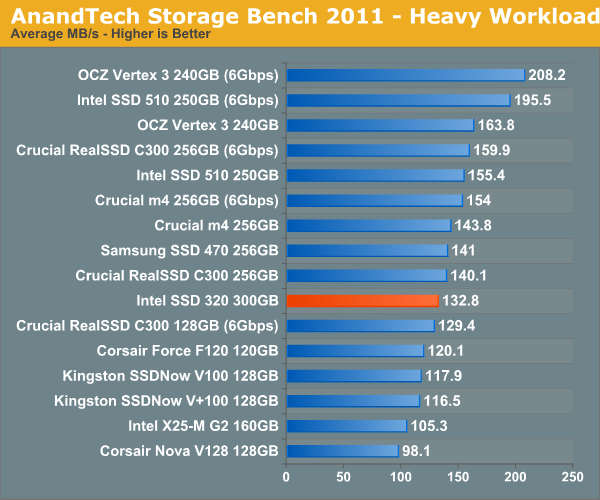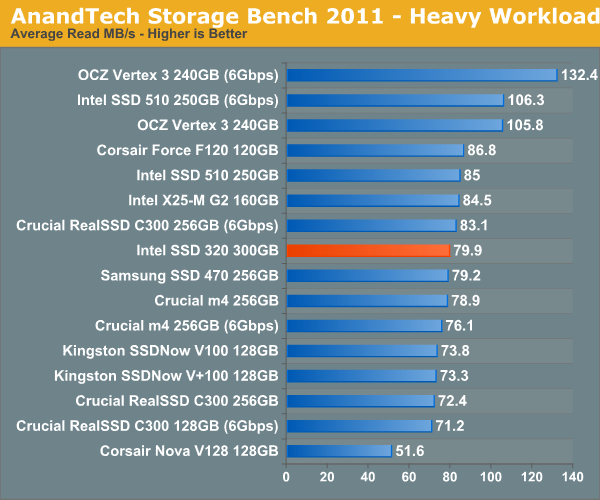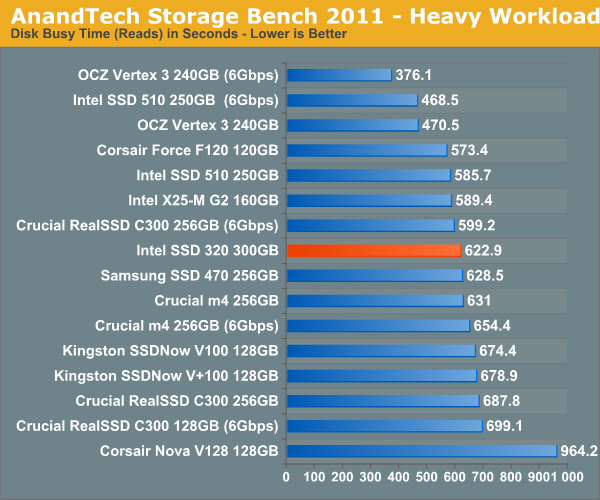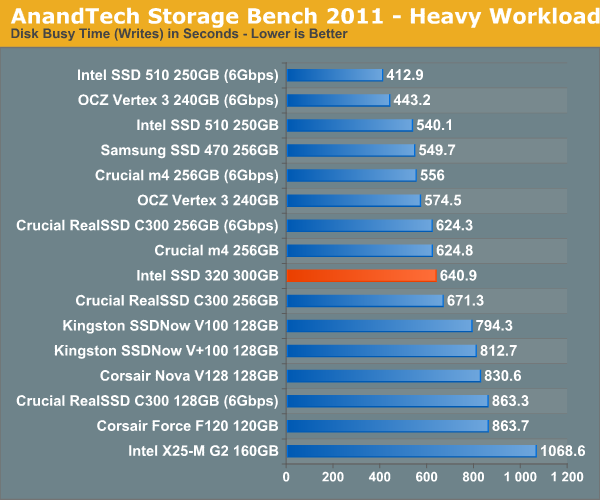The Intel SSD 320 Review: 25nm G3 is Finally Here
by Anand Lal Shimpi on March 28, 2011 11:08 AM EST- Posted in
- IT Computing
- Storage
- SSDs
- Intel
- Intel SSD 320
AnandTech Storage Bench 2011: Much Heavier
I didn't expect to have to debut this so soon, but I've been working on updated benchmarks for 2011. Last year we introduced our AnandTech Storage Bench, a suite of benchmarks that took traces of real OS/application usage and played them back in a repeatable manner. I assembled the traces myself out of frustration with the majority of what we have today in terms of SSD benchmarks.
Although the AnandTech Storage Bench tests did a good job of characterizing SSD performance, they weren't stressful enough. All of the tests performed less than 10GB of reads/writes and typically involved only 4GB of writes specifically. That's not even enough exceed the spare area on most SSDs. Most canned SSD benchmarks don't even come close to writing a single gigabyte of data, but that doesn't mean that simply writing 4GB is acceptable.
Originally I kept the benchmarks short enough that they wouldn't be a burden to run (~30 minutes) but long enough that they were representative of what a power user might do with their system.
Not too long ago I tweeted that I had created what I referred to as the Mother of All SSD Benchmarks (MOASB). Rather than only writing 4GB of data to the drive, this benchmark writes 106.32GB. It's the load you'd put on a drive after nearly two weeks of constant usage. And it takes a *long* time to run.
I'll be sharing the full details of the benchmark in some upcoming SSD articles but here are some details:
1) The MOASB, officially called AnandTech Storage Bench 2011 - Heavy Workload, mainly focuses on the times when your I/O activity is the highest. There is a lot of downloading and application installing that happens during the course of this test. My thinking was that it's during application installs, file copies, downloading and multitasking with all of this that you can really notice performance differences between drives.
2) I tried to cover as many bases as possible with the software I incorporated into this test. There's a lot of photo editing in Photoshop, HTML editing in Dreamweaver, web browsing, game playing/level loading (Starcraft II & WoW are both a part of the test) as well as general use stuff (application installing, virus scanning). I included a large amount of email downloading, document creation and editing as well. To top it all off I even use Visual Studio 2008 to build Chromium during the test.
Many of you have asked for a better way to really characterize performance. Simply looking at IOPS doesn't really say much. As a result I'm going to be presenting Storage Bench 2011 data in a slightly different way. We'll have performance represented as Average MB/s, with higher numbers being better. At the same time I'll be reporting how long the SSD was busy while running this test. These disk busy graphs will show you exactly how much time was shaved off by using a faster drive vs. a slower one during the course of this test. Finally, I will also break out performance into reads, writes and combined. The reason I do this is to help balance out the fact that this test is unusually write intensive, which can often hide the benefits of a drive with good read performance.
There's also a new light workload for 2011. This is a far more reasonable, typical every day use case benchmark. Lots of web browsing, photo editing (but with a greater focus on photo consumption), video playback as well as some application installs and gaming. This test isn't nearly as write intensive as the MOASB but it's still multiple times more write intensive than what we were running last year.
As always I don't believe that these two benchmarks alone are enough to characterize the performance of a drive, but hopefully along with the rest of our tests they will help provide a better idea.
The testbed for Storage Bench 2011 has changed as well. We're now using a Sandy Bridge platform with full 6Gbps support for these tests. All of the older tests are still run on our X58 platform.
AnandTech Storage Bench 2011 - Heavy Workload
We'll start out by looking at average data rate throughout our new heavy workload test:

Overall performance is decidedly last generation. The 320 is within striking distance of the 510 but is slower overall in our heavy workload test.
The breakdown of reads vs. writes tells us more of what's going on:


The next three charts just represent the same data, but in a different manner. Instead of looking at average data rate, we're looking at how long the disk was busy for during this entire test. Note that disk busy time excludes any and all idles, this is just how long the SSD was busy doing something:













194 Comments
View All Comments
LeTiger - Monday, March 28, 2011 - link
If Intel's not careful... they will price and performance themselves out of the very market they sought to create in the first place...nexox - Monday, March 28, 2011 - link
Meh, this is the cheapest SSD with some form of capacitor backup for volatile data - to get something similar you need to go to a SandForce 1500 or 2500 controller, and probably expect to pay 2-3x as much. Most people aren't too concerned with this, but it's an essential feature, no matter what the manufacturers say.It's also the only SSD I've seen that doesn't exhibit random latency spikes, that combined with the power fail protection means that it's the only SSD I'd consider buying.
cactusdog - Tuesday, March 29, 2011 - link
At least with Intel you are guaranteed to get best quality nand and reliable performance over the long term. Intel have also done the right thing by rebranding 25nm drives, even though in Intel's case performance is a little better than their 34nm drives.With OCZ, theres no way of knowing which nand you will get and you could end up with second rate nand not intended for high performance SSD's.
Intel's performance is very reliable over the long term, whereas OCZ/sandforce 3GB/s drives are known to slow to a "settled state" especially with smaller drives.
Intel will sell plenty of these drives because they are reliable and trustworthy.
Griswold - Tuesday, March 29, 2011 - link
Exactly. Not everybody plays benchmarks all day long and doesnt care one bit about reliability of the storage system.wumpus - Tuesday, March 29, 2011 - link
And just how many filesystems automatically write everything the instant write() is called? It is a bad idea for rotating media, and will take awhile before filesystems optimized for SSDs show up (Microsoft has been promising a database centric filesystem for the "next windows" since NT was new. Maybe someday.) Also, NTFS has corruption issues with standard hard drives, this isn't going to help that reliability much anyway. You need backups, a real UPS, and RAID (in roughly that order) if you care about data reliability.If intel was willing to compete largely on reliability, they could double the price (if data on SRAM competition is even more expensive), as such a feature is worth much more than any amount of hardware cost to a large number of customers. Don't expect to get it without major software surgery (and yes, some of those customers have the software).
seapeople - Tuesday, March 29, 2011 - link
I don't understand all the negative feedback on this drive. For the 90% of us who have 3Gbps SATA, compared to the Vertex 3 this drive is:~25% slower than Vertex 3
~20% cheaper than Vertex 3
Why is that so terrible, the Vertex 3 is an amazing performance feat, and under common mainstream conditions this drive is about equal on a price/performance basis.
Meanwhile, this drive gives us 20% more performance than the g2 generation while being ~20% cheaper. This is far from sad.
dagamer34 - Tuesday, April 5, 2011 - link
Except the MSRP for a 120GB Vertex 3 is cheaper than what an equally sized Intel SSD 320 series drive costs. That's simply laughable. Higher price for worse performance? Throwing up the "reliability" card is a red herring when you consider that the 25nm process is brand new, you don't get to state that for any technology until it's been around on the market for quite some time (otherwise, it's just name recognition only, and that worked so well for Sandy Bridge chipsets).seapeople - Thursday, April 7, 2011 - link
You're on crack. A 120 GB Vertex 3 is listed as 249.99 versus 209.00 for the 120 GB Intel SSD 320.Furthermore, SSD reliability issues generally arise from controller/firmware nuances and bugs, not the new process node. It sounds like the SSD 320 is basically the g2 with new flash and a few features unlocked, so it's reasonable to expect similar controller reliability. Apart from that, basically everyone uses the same flash anyway, so if the Intel drive dies because of the new flash process then so will the Vertex.
andreyu - Thursday, July 21, 2011 - link
1. you're blind or on crack2. you bought a ocz/corsair ssd cause you wanted speed but returned it for problems and now you're mad on intel?
3.so sorry 4 u
120 GB Intel SSD 320 is CHEAPER than 120 GB Vertex 3
TonyB - Monday, March 28, 2011 - link
lol